
The Castro Theatre is a historic movie palace in the Castro District of San Francisco, California. The venue became San Francisco Historic Landmark #100 in September 1976. Located at 429 Castro Street, it was built in 1922 with a California Churrigueresque façade that pays homage—in its great arched central window surmounted by a scrolling pediment framing a niche—to the basilica of Mission Dolores nearby. Its designer, Timothy L. Pflueger, also designed Oakland's Paramount Theater and other movie theaters in California during that period. The theater has more than 1,400 seats.
Landmark Theatres is a movie theatre chain founded in 1974 in the United States. It was formerly dedicated to exhibiting and marketing independent and foreign films. Landmark consists of 34 theatres with 176 screens in 24 markets. It is known for both its historic and newer, more modern theatres. Helmed by its President Kevin Holloway, Landmark Theatres is part of Cohen Media Group.
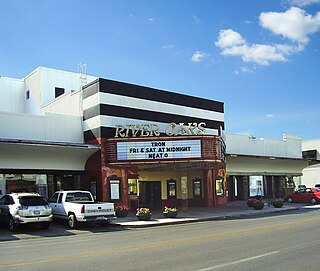
The River Oaks Theatre is a historic movie theater located in the River Oaks Shopping Center in the Neartown community in Houston, Texas, United States, east of the River Oaks community. The theater has three projection screens; one large screen, downstairs, and two smaller screens, upstairs.

Timothy Ludwig Pflueger was an architect, interior designer and architectural lighting designer in the San Francisco Bay Area in the first half of the 20th century. Together with James R. Miller, Pflueger designed some of the leading skyscrapers and movie theaters in San Francisco in the 1920s, and his works featured art by challenging new artists such as Ralph Stackpole and Diego Rivera. Rather than breaking new ground with his designs, Pflueger captured the spirit of the times and refined it, adding a distinct personal flair. His work influenced later architects such as Pietro Belluschi.
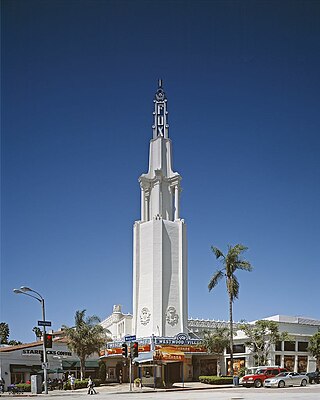
The Regency Village Theatre is a historic, landmark cinema in Westwood, Los Angeles, California. Westwood Village, in the heart of Westwood, is near the University of California, Los Angeles (UCLA). It is currently operated by the Regency Theaters chain. The Westwood Village Theatre has been the site for many Hollywood movie premieres in Los Angeles. The seating capacity of the cinema is about 1,400.

The Alhambra Theatre is a Moorish Revival movie theater building at 2330 Polk Street in San Francisco, California, that opened on November 5, 1926. The theater was designed by Miller & Pflueger.

Reid & Reid, also known as Reid Brothers, was an American architectural and engineering firm that was active from 1880 to 1932. Established in Indiana by Canadian immigrants, the firm moved to the West Coast and became was the most prominent firm in San Francisco, California in the late 19th and early 20th centuries.

The Nimoy Theater, formerly known as Crest, Majestic Crest and Bigfoot Crest Theatre, is a movie theatre located in the Westwood neighborhood of Los Angeles, California. It was founded as the UCLAN in 1941, and was built for live performances but switched to a newsreel cinema during World War II. Through ownership changes, it has been known at various times as UCLAN Theatre, Crest Theatre, and Metro Theatre. The original 500-seat art deco style theater was designed by Arthur W. Hawes.

The Fox Theatre in Redwood City, CA opened in 1929, was remodeled in 1950, and was listed on National Register of Historic Places in 1994.

The New Mission Theater is a historic building, built in 1916 and is located at 2550 Mission Street in San Francisco, California.
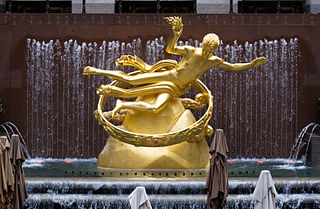
The Art Deco style, which originated in France just before World War I, had an important impact on architecture and design in the United States in the 1920s and 1930s. The most notable examples are the skyscrapers of New York City, including the Empire State Building, Chrysler Building, and Rockefeller Center. It combined modern aesthetics, fine craftsmanship, and expensive materials, and became the symbol of luxury and modernity. While rarely used in residences, it was frequently used for office buildings, government buildings, train stations, movie theaters, diners and department stores. It also was frequently used in furniture, and in the design of automobiles, ocean liners, and everyday objects such as toasters and radio sets.

The Piedmont Theatre, located on Piedmont Avenue in Oakland, California, is Oakland's oldest continuously operating movie theater.

The Metro Theater is a defunct movie theater at 2626 Broadway on the Upper West Side of Manhattan in New York City. It was designed by architecture firm Boak and Paris and built between 1932 and 1933. The theater is designed in the Art Deco style and originally contained 550 seats. Although the theater's interior was demolished after it was closed in 2005, the original facade remains intact as of 2023 and is a New York City designated landmark.

Clay Theatre is a historic 1913 single screen theater building in the Pacific Heights neighborhood of San Francisco, California, United States. It was formerly known as The Regent, The Avalon, The Clay International, and Landmark's Clay Theatre. It has been listed as a San Francisco Designated Landmark since May 6, 2022.

The California Theatre is a historic theatre in Old Town Pittsburg, Callifornia.
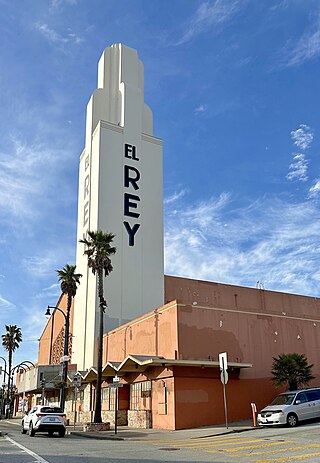
El Rey Theatre is a historic theater building in the Ingleside Terraces neighborhood of San Francisco, California, United States. The building is listed by the city as a San Francisco Designated Landmark since 2017.
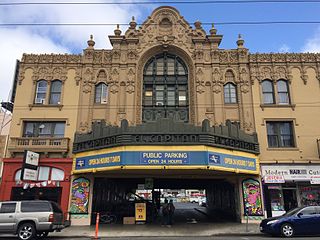
El Capitan Theatre and Hotel, or The Cap, is a historic 1928 building containing a hotel, shops, and a former luxury vaudeville and movie theater in the Mission District of San Francisco, California. It has been listed by the city as a San Francisco Designated Landmark, since March 3, 1996.

















